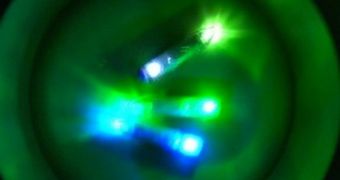If power efficiency is crucial in MacBooks and iPhones, Apple needs to work wonders to do the same for the iWatch, the company’s upcoming wearable computer focused on health and fitness.
But it may just be that someone else will do the magic for them. A company spokesperson has confirmed to TechCrunch that Apple has acquired LuxVue Technology, which specializes in low-power micro-LEDs that actually output more lumens than traditional light emitting diodes.
“Apple buys smaller technology companies from time to time, and we generally do not discuss our purpose or plans,” the company spokesperson said, which is pretty much all the confirmation you’ll ever get from Apple that it has engulfed new IP.
LuxVue is just one of over two dozen companies acquired by the Mac maker in the past 18 months.
According to mLED, another supplier of micro-LED parts, the benefits of using this technology are sky-high.
“Available technologies can be divided into two principal types – direct emissive, and modulated. The former category includes OLED and micro-LED, whilst the latter describes technologies such as Liquid Crystal on Silicon (LCoS) and Digital Light Processing (DLP MEMS). Modulated displays generally incorporate three bespoke components: external light source; combiner optics; pattern generator.”
“In this case the light is first directed to the external pattern generator. The image is then formed by either switching on or off each pixel in the array. For this type of non-emissive system, light must always be incident on every pixel. Consequently if only 15% of the pixels are typically on (e.g. to form standard images on video and HMDs) then 85% of the incident light is wasted. This is an undesirable trait for any portable application where battery life is paramount.”
Which is where micro-LEDs come in and save the day. Both OLED technology and micro-LED technology work around power consumption by combining the three components required in the modulated approach into a single array that emits light, essentially preventing any leaks, or dumps in light.
But micro-LEDs go even further than OLED, as mLED notes.
“Whilst OLED displays share this advantage with micro-LEDs, they are limited in brightness and experience short device life-times when run in higher brightness conditions. Micro-LEDs have been demonstrated operating with at least thirty times the brightness of an OLED display. For this reason, mLED’s microLED technology delivers a unique, elegantly simple, ultra-high brightness solution.”
LuxVue’s solution supposedly does an even better job at power management, since Apple bought them and not mLED.

 14 DAY TRIAL //
14 DAY TRIAL //